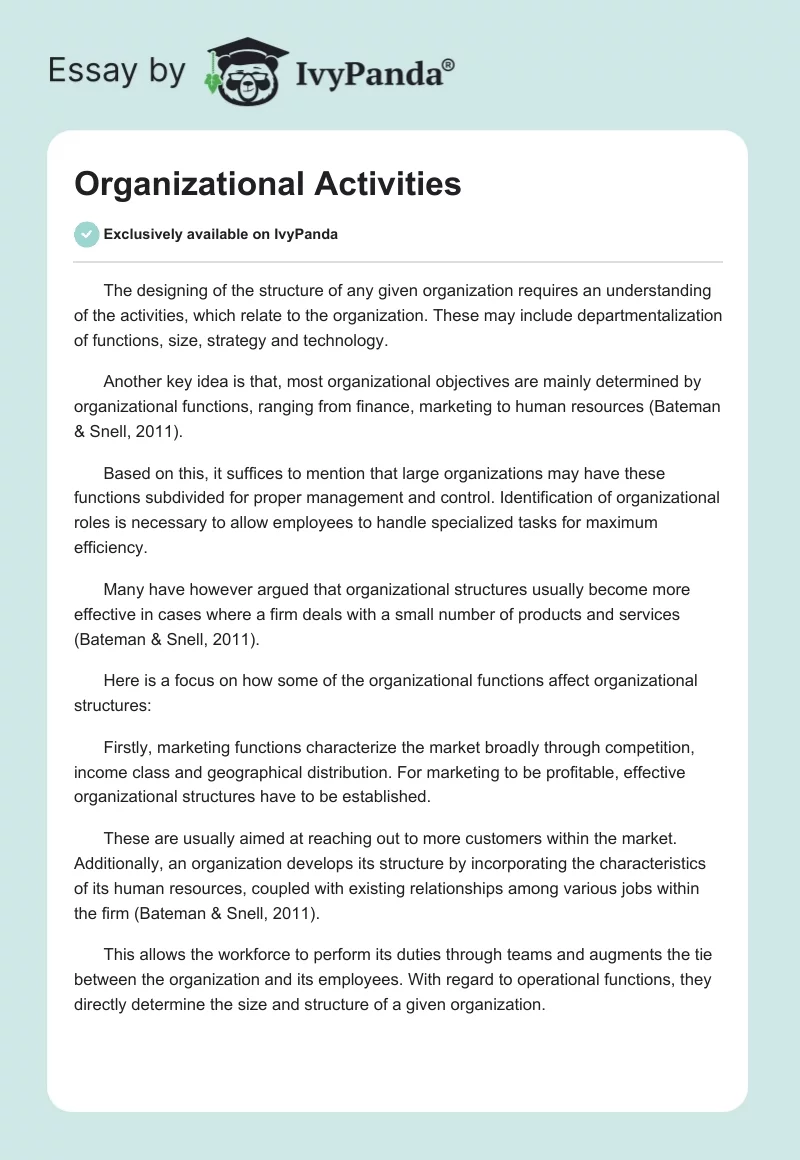The designing of the structure of any given organization requires an understanding of the activities, which relate to the organization. These may include departmentalization of functions, size, strategy and technology.
Another key idea is that, most organizational objectives are mainly determined by organizational functions, ranging from finance, marketing to human resources (Bateman & Snell, 2011).
Based on this, it suffices to mention that large organizations may have these functions subdivided for proper management and control. Identification of organizational roles is necessary to allow employees to handle specialized tasks for maximum efficiency.
Many have however argued that organizational structures usually become more effective in cases where a firm deals with a small number of products and services (Bateman & Snell, 2011).
Here is a focus on how some of the organizational functions affect organizational structures:
Firstly, marketing functions characterize the market broadly through competition, income class and geographical distribution. For marketing to be profitable, effective organizational structures have to be established.
These are usually aimed at reaching out to more customers within the market. Additionally, an organization develops its structure by incorporating the characteristics of its human resources, coupled with existing relationships among various jobs within the firm (Bateman & Snell, 2011).
This allows the workforce to perform its duties through teams and augments the tie between the organization and its employees. With regard to operational functions, they directly determine the size and structure of a given organization.
Common types of organizational structures are matrix, functional and divisional structures among others. Functional structures allow the classification of the organization, depending on various purposes.
In most cases, it allows formation of departments, which heavily rely on talents and knowledge of individual leaders. Nevertheless, its success has always been hampered by limited communication among departments, emanating from organizational boundaries.
On the other hand, divisional structure is common in large organizations, which operate within a large geographical space (Bateman & Snell, 2011). This type of structure allows an organization to achieve its target easily and more effectively.
However, excellent communication is affected since customers work in separate regions. Small organizations can also use this structure by applying it on a small-scale, through creation of offices in different locations of the city. Lastly, the matrix structure is a hybrid of functional and divisional structures.
It is common in large organizations and allows benefits, emanating from the above structures to be centralized. However, it faces management struggles due to the existence of dual leadership.
The three structures are effective if they are well crafted to address the objectives of an organization.
The choice and effectiveness of an organizational structure may depend on the firm’s size, and can be determined through surveys and evaluation of the entire structure.
Toyota organizational structure

Due to the global size of Toyota, it has adopted several structures that meet its needs. However, the divisional structure of the company is essential.
This has allowed the company to address the needs of different regions around the world. The experience at Toyota was fruitful; its workforce is classified depending on skills and knowledge to allow specialization.
Due to the ever-changing business environment, there is need for flexibility and responsiveness in management of firms.
For instance, the manner in which business was done fifty years ago is not the same today. As a result, firms have to shift in order to address new challenges and compete favorably with other players in the market.
Reference
Bateman, T. S., & Snell, S. A. (2011). Management: Leading & collaborating in a competitive world. New York, NY: McGraw-Hill Irwin.


